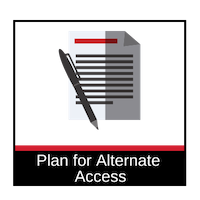At CSUN, we require vendors of Information and Communication Technology (ICT) products and services to provide documentation about the accessibility of their products and work with the university to mitigate any accessibility issues or concerns identified. Below is an overview of the documentation you may be required to provide as well as well as some of the accessibility reviews your products may undergo.
- Accessibility Conformance Report (ACR or VPAT)
- Vendor Accessibility Assessment Form
- Accessibility Demo
- Accessibility Review
- Accessibility Roadmap
Accessibility Conformance Report (ACR or VPAT)
When conducting business at CSUN, ICT vendors must provide an Accessibility Conformance Report (ACR or VPAT®) of their product. The ACR is a report provided by the Information Technology Industry Council (ITI) that documents information related to the accessibility features of an ICT product or service. Through this report, vendors must indicate their products conformance to ICT accessibility standards including Section 508 (U.S.), W3C/WAI WCAG 2.0, and EN 301 549 (EU). A full description of the template for an ACR can be found at ITI’s VPAT ® page.
At CSUN, we require vendors to complete the latest version of the template*. The ACR is required at CSUN for ICT products that will be used by a high volume of end users across campus. Failure to provide an ACR when requested can prevent future purchases or renewals of a product.
To obtain the latest VPAT template, go to ITI’s VPAT ® page. The VPAT is located under the Resources section at the bottom of the page. Select the VPAT titled VPAT 2.x Rev 508.
* As of October 2018, CSUN will no longer accept VPAT version 1.0.
Vendor Accessibility Assessment Form
The Vendor Accessibility Assessment Form is an internal campus form designed to initiate the conversation of accessibility between the vendor and the accessibility review team at the Universal Design Center (UDC). This form will ask vendors to provide information about their accessibility practices and methods used to validate conformance. The form will also ask vendors to provide any other information they have related to accessibility including websites and accessibility testing reports.
A link to the latest form is below:
Accessibility Demo
For prominent public facing ICT products or services, vendors may be asked to provide an accessibility demonstration of their product by the department purchasing or by the UDC. This is an opportunity for companies to showcase their accessibility practices. During the demo, the UDC or department purchasing the product may ask targeted questions on accessibility or may ask for a live demo of accessibility conformance in specific areas.
Potential questions:
- Describe how you integrated accessibility into your development process?
- Demonstrate accessibility conformance in the following areas
Accessibility Review
Products that will be used by a large number of CSUN students, faculty, staff or the general public may undergo an accessibility review by the UDC. The review is meant to identify key areas where accessibility gaps may be present that will prevent users with disabilities from accessing information or may cause difficulties in their overall experience.
VPAT Review
An ACR review is the most common review conducted for ICT products being used by a large volume of users on campus. During the ACR review, the UDC will review the company's stated conformance level and remarks and explanations supporting the conformance level. The UDC will provide commentary on this and may send the vendor this information. The UDC may require a company to update their ACR before any future purchase or renewals of their products can be completed.
Accessibility Conformance Test
Vendors whose products will be campus-wide purchases or pose a high risk to the campus will undergo an accessibility conformance test. To conduct this review, the UDC will ask the department purchasing or the vendor to provide a test instance or demo page in order to evaluate the product against accessibility standards defined by Section 508, WCAG 2.0 and CSU ATI criteria. In addition, the UDC may conduct a review using assistive technology (e.g., screen readers) and if a product is a mobile device, the UDC will test against Mobile Web Best Practices (MWBP), Mobile Web Application Best Practices (MWABP), and Mobile Accessibility Guidelines.
The UDC will develop a report outlining all critical accessibility gaps identified. The report will also provide recommendations on methods to enhance the accessibility of the product. The report will go to the department first and departments may send the report to the vendor to determine what accessibility can be fixed by the company.
Accessibility Roadmap
After the completion of an ACR review or an accessibility conformance test, the UDC may ask vendors to provide an accessibility roadmap that outlines what their expected timeframe is to correct any accessibility deviations encountered in their product. For accessibility issues that cannot be fixed, companies should provide information to known workarounds for their products or suggestions to alternatives that will get users to the same endpoint.









